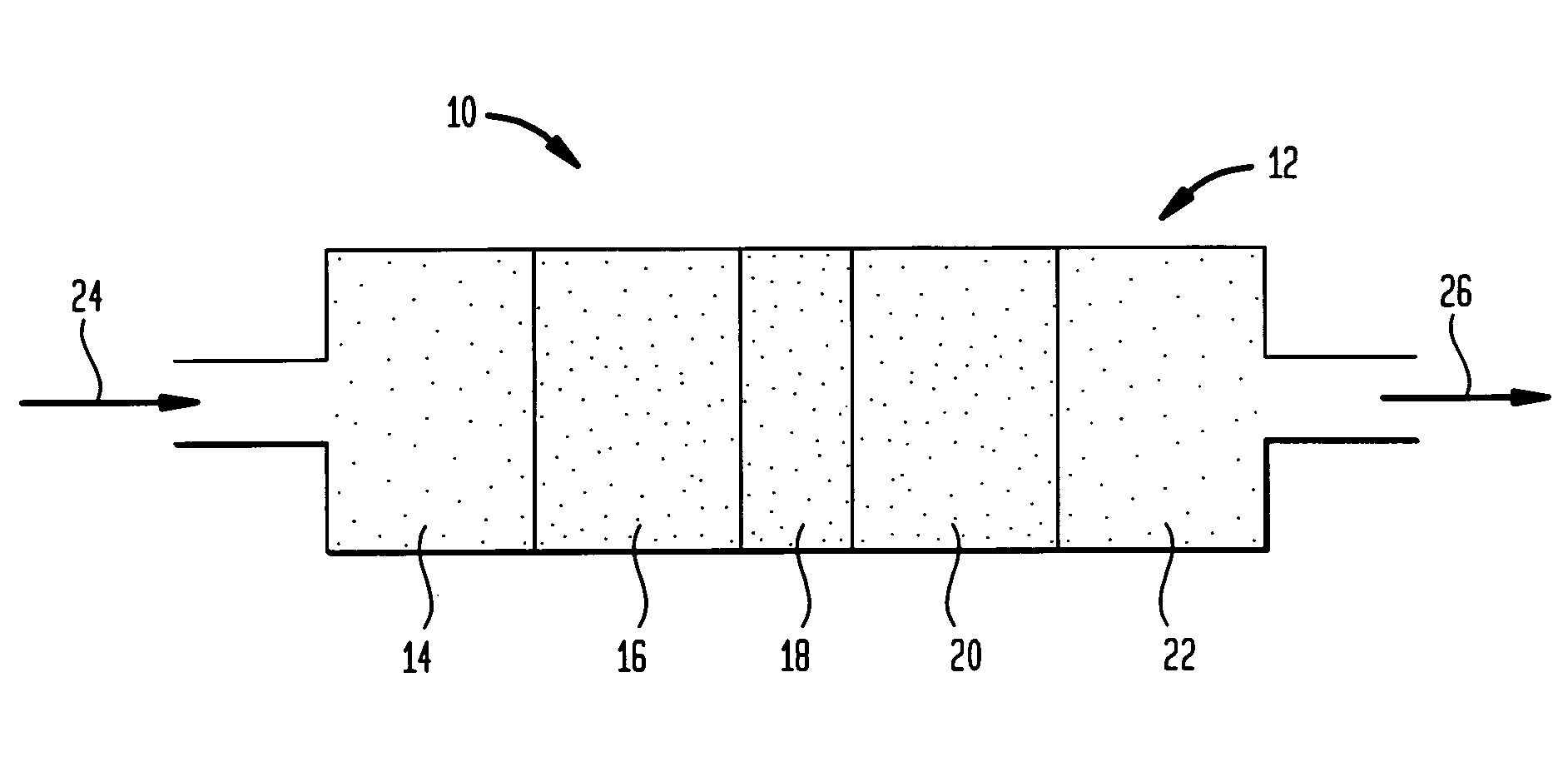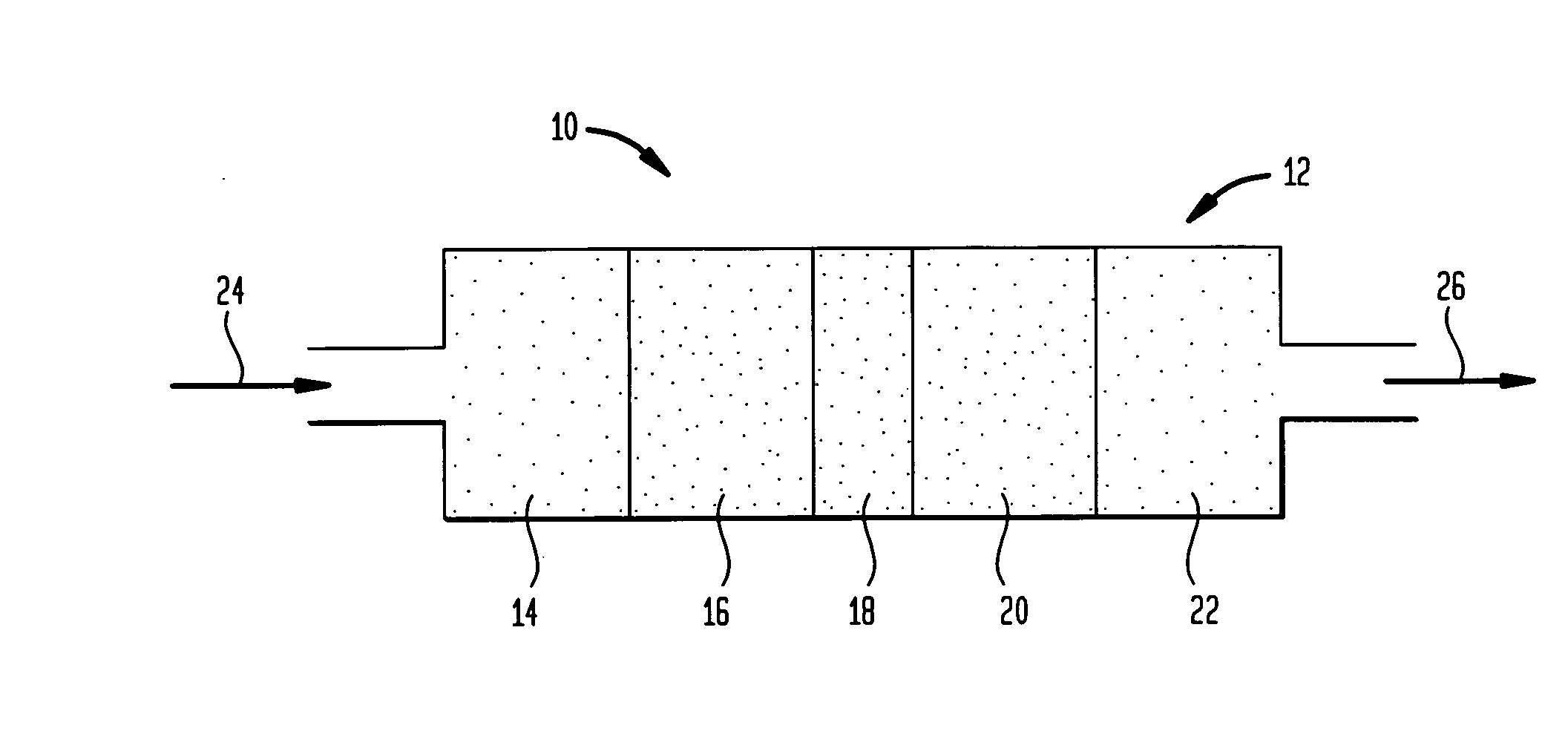Ethylene production from acetic acid utilizing dual reaction zone process
a technology of acetic acid and reaction zone, which is applied in the direction of physical/chemical process catalysts, bulk chemical production, metal/metal-oxide/metal-hydroxide catalysts, etc., can solve the problem that existing processes do not have the requisite selectivity to ethylene or existing
- Summary
- Abstract
- Description
- Claims
- Application Information
AI Technical Summary
Benefits of technology
Problems solved by technology
Method used
Image
Examples
example a
Preparation of 5 Weight Percent Copper on Iron Oxide
[0058]Powdered and meshed iron oxide (100 g) of uniform particle size distribution of about 0.2 mm was dried at 120° C. in an oven under nitrogen atmosphere overnight and then cooled to room temperature. To this was added a solution of copper nitrate (17 g) in distilled water (100 ml). The resulting slurry was dried in an oven gradually heated to 110° C. (>2 hours, 10° C. / m in.). The impregnated catalyst mixture was then calcined at 500° C. (6 hours, 1° C. / min).
example b
Preparation of H-Mordenite Zeolite
[0059]H-Mordenite zeolite was prepared by calcination of ammonium form Mordenite at 500-550° C. for 4-8 hours. If the sodium form of Mordenite is used as a precursor, the sodium Mordenite is ion-exchanged to ammonium form prior to calcination.
Gas Chromatographic (GC) Analysis of the Products
[0060]The analysis of the products was carried out by online GC. A three channel compact GC equipped with one flame ionization detector (FID) and 2 thermal conducting detectors (TCDs) was used to analyze the reactants and products. The front channel was equipped with an FID and a CP-Sil 5 (20 m)+WaxFFap (5 m) column and was used to quantify:
[0061]Acetaldehyde
[0062]Ethanol
[0063]Acetone
[0064]Methyl acetate
[0065]Vinyl acetate
[0066]Ethyl acetate
[0067]Acetic acid
[0068]Ethylene glycol diacetate
[0069]Ethylene glycol
[0070]Ethylidene diacetate
[0071]Paraldehyde
[0072]The middle channel was equipped with a TCD and Porabond Q column and was used to quantify:
[0073]CO2
[0074]Et...
example 1
[0083]The catalysts utilized were a copper on iron oxide catalyst, T-4489 purchased from Sud Chemie and an H-mordenite zeolite prepared by replacing with hydrogen ions all but 500 ppm based on the weight of the zeolite of the sodium ions in a sodium aluminosilicate mordenite catalyst prepared in accordance with U.S. Pat. No. 4,018,514 or equivalent in which the ratio of silica to alumina is preferably in the range of from about 15:1 to about 100:1. A suitable catalyst is CBV21A available from Zeolyst International, which has a silica to alumina ratio of about 20:1.
[0084]In a tubular reactor made of stainless steel, having an internal diameter of 30 mm and capable of being raised to a controlled temperature, there are arranged 30 ml of 5 weight percent copper on iron oxide catalyst as top layer and 20 ml of H-mordenite as a bottom layer. The length of the combined catalyst bed after charging was approximately about 70 mm.
[0085]A feed liquid was comprised essentially of acetic acid. T...
PUM
| Property | Measurement | Unit |
|---|---|---|
| temperature | aaaaa | aaaaa |
| temperature | aaaaa | aaaaa |
| pressure | aaaaa | aaaaa |
Abstract
Description
Claims
Application Information
 Login to View More
Login to View More - R&D
- Intellectual Property
- Life Sciences
- Materials
- Tech Scout
- Unparalleled Data Quality
- Higher Quality Content
- 60% Fewer Hallucinations
Browse by: Latest US Patents, China's latest patents, Technical Efficacy Thesaurus, Application Domain, Technology Topic, Popular Technical Reports.
© 2025 PatSnap. All rights reserved.Legal|Privacy policy|Modern Slavery Act Transparency Statement|Sitemap|About US| Contact US: help@patsnap.com



